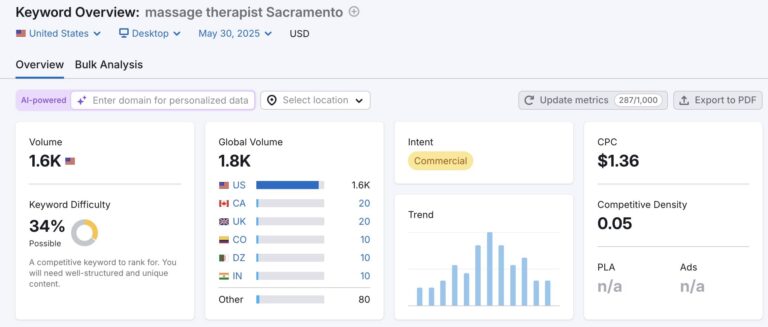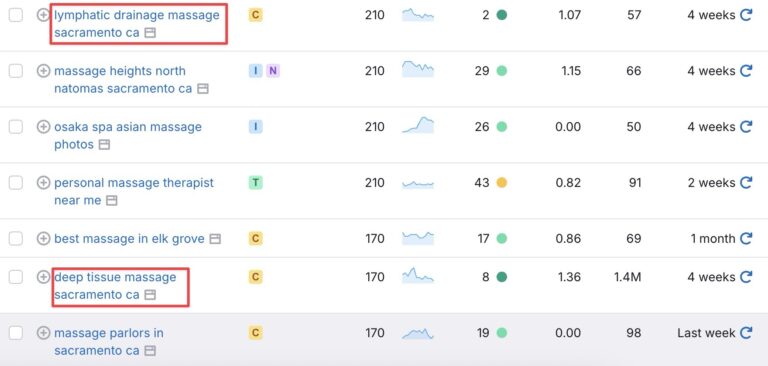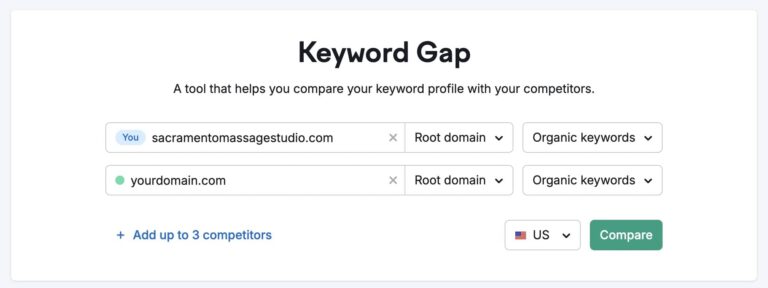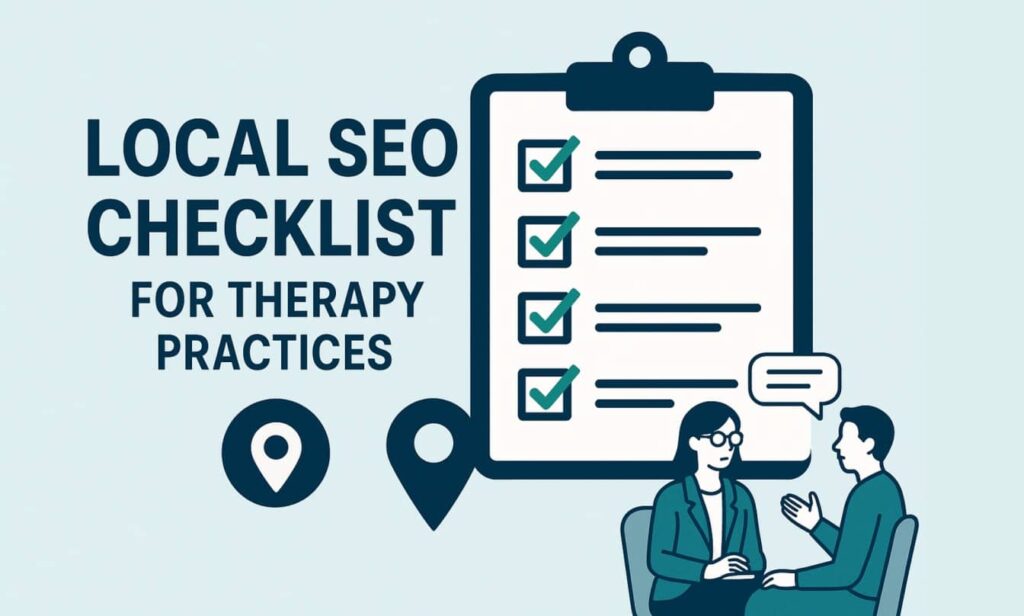A while back, I worked with a massage therapist whose website was buried somewhere on page 3 of Google. Great service, loyal clients, but almost invisible online. No bookings coming through Google, barely any map views, and definitely no leads from “massage near me” searches. Sound familiar?
In this article, I’m sharing the exact Local SEO tips for massage therapists that I used to turn things around. No theory. Just what I actually did, from fixing their Google Business Profile to building local signals that Google trusts. If you run a massage therapy clinic and want to rank in your area, this isn’t fluff. It’s the playbook I use when I need results.
What Local SEO Actually Means for Massage Therapists
If you’re a massage therapist trying to grow your local client base, SEO can feel like just another overwhelming tech term. I get it. You didn’t start your practice to figure out algorithms. You want a full calendar and a steady flow of new clients.
Here’s what actually matters. Local SEO is what helps people find you instead of the clinic down the street. It’s how Google decides which massage businesses show up when someone nearby searches for “massage near me” or “sports massage in [your city].”
It’s not just about having a website. It’s about sending the right signals to Google. Things like where you’re located, what types of massage you offer, and whether your practice is relevant and trustworthy.
When I work with massage therapists, I skip the fluff and focus on what’s missing. Is the Google Business Profile only half complete? Is the website missing key local phrases? Are there any local backlinks at all? These are the details that actually move rankings.
Get this part right, and you won’t just show up. You’ll show up where it counts: in Google Maps, in the local 3-pack, and right in front of people ready to book.
What Local SEO Actually Does for Your Massage Business
I’ve worked with massage therapists who offer incredible services, but their schedules were still half-empty. The issue wasn’t the quality of their work. It was that people simply weren’t finding them online.
That’s where local SEO tips for massage therapists come in.
It helps your practice appear when someone nearby searches things like “sports massage near me” or “back pain massage in [your city].” And not on page two where no one clicks, but right where people are ready to take action.
The biggest advantage? It brings in the right traffic. These aren’t random visitors just browsing. These are people in your area actively looking to book a massage. When they land on your site or Google listing and see your services, reviews, and location, it becomes an easy decision to choose you.
Even small improvements, like adding the right keywords to your service pages or earning a few local backlinks, can shift the results. I’ve seen massage therapists go from a few weekly bookings to a consistently packed calendar by simply getting their SEO foundations right.
If you’re looking for practical local SEO tips for massage therapists, this isn’t theory. This is what I do every day for real businesses. And it works.
How Local SEO Drives More Bookings for Massage Therapists
When someone near you searches for a massage, like “deep tissue massage in [city]” or “massage therapist near me,” they want quick, trustworthy results. That’s where local SEO does the heavy lifting.
I’ve seen this play out many times. Once a massage therapist’s website and Google Business Profile start showing up in front of the right people at the right time, things change fast. You don’t just get clicks. You get actual appointments.
Local SEO puts you in front of the people who are ready to book. When your business shows up in the Google 3-Pack, the local listings box that appears at the top of search, it builds instant trust. That visibility leads to more calls, more form submissions, and more clients walking into your practice.
But ranking alone isn’t enough. What really builds trust is showing up with complete, accurate details. Your location, your massage specialties, and your real reviews are what make people feel confident enough to choose you.
I’ve worked with massage therapists who saw their bookings double after we fixed a few key things. We improved location signals, cleaned up their profile setup, and made some simple changes on the site that helped Google understand where they are and what they offer. It’s not about doing everything. It’s about doing the right things.
And now more than ever, getting this right matters. A 2023 study by BrightLocal showed that website traffic from Google Maps dropped by 15 to 20 percent compared to the previous year. This drop was caused by changes in how Google displays local results and an increase in paid ads above organic listings.
Another report by Moz found that businesses with outdated or incomplete Google Business Profiles lost up to 25 percent of their traffic from map searches. That’s a major setback, especially if your local SEO isn’t fully set up.
Even though 82 percent of people still use Google Maps to search for local services, the number of users clicking through to actual websites has gone down. This means if your local SEO isn’t strong, you’re missing out on people who are ready to book with you.
If you’re serious about growing your massage business, local SEO is not optional. It’s what helps you show up where it matters most, right when people are looking to book.
8 Easy Local SEO Tips for Massage Therapists
Now that you understand why local SEO matters and how it drives real bookings, let’s talk about what to do next.
It’s not enough to just have a website or a Google listing. You need the right pieces in place if you want to show up when local clients are searching for massage therapy.
Over the past few years, I’ve helped massage therapists go from barely visible online to fully booked. And it always comes down to the same core areas: location signals, content, trust, and consistency.
So if you’re wondering where to start or what to fix, these are the 8 most effective tips I recommend to get your massage therapy website ranking locally.
Let’s break them down one by one.
1. Optimize Your Google Business Profile
Your Google Business Profile (formerly Google My Business) is the first thing most local clients will see when they search for massage services. It’s not just a listing, it’s your online storefront. If it’s incomplete or outdated, you’re leaving bookings on the table.
Here’s how to get it right:
Make sure everything matches
Use your real business name, correct address, and local phone number. Consistency matters. Google checks this info across the web, so if it doesn’t match everywhere, it can hurt your visibility.
Write a description that works for the search
Your business description should be clear, but also include keywords people actually type. Think “deep tissue massage in [your city]” or “sports injury massage near me.” This helps Google match your listing to local searches.
Add high-quality photos
Upload real photos of your treatment room, waiting area, signage, and even happy clients (with permission). These not only make your business look more professional but also build trust. Listings with photos get more clicks and calls.
Post regular updates
Share any promotions, availability updates, or new services using Google Posts. It shows that your business is active, and Google favors listings that stay fresh.
2. Keep Your NAP Info Consistent
One of the easiest ways to hurt your local SEO without realizing it is by having inconsistent NAP info: your business Name, Address, and Phone number. Google checks this across your website, your Google Business Profile, and directories like Yelp, Bing Places, and others.
If your business is listed as “Zen Massage Therapy” in one place and “Zen Therapy Center” somewhere else, or if the phone number is outdated, Google may get confused. That confusion leads to lower rankings. Worse, potential clients may get frustrated and move on to someone else.
The fix is simple: pick one format for your business name, address, and phone number, and use it everywhere. Use the same punctuation, spelling, and structure each time.
This consistency helps build trust with Google and with people searching for your services. It shows you’re a real business and makes it easier for clients to contact or visit you without second-guessing the info.
3. Keyword Research for Massage Therapists
There are many ways to find profitable keywords for your massage therapy business. In this section, we’ll go over the most effective methods to discover keywords that can actually bring you traffic and clients, using SEMrush as our primary tool.
So, without any delay, let’s jump into the first method.
Why Keyword Research Matters?
Have you ever searched “massage therapist near me” and noticed some local competitors are always at the top of the Google search results? It’s not a coincidence — it’s a result of smart keyword research and SEO strategy.
What if I told you that you can reverse-engineer their strategy and even outrank them?
Yes, you absolutely can, and today I’ll show you how.
Let’s begin.
Start with Seed Keywords
First, we need a seed keyword, something basic that a potential client might type into Google. Let’s take:
- “Massage therapist Sacramento”
- “Swedish massage near me”
- “Deep tissue massage Sacramento”
These keywords are what we’ll build our research around.
Now open up SEMrush and enter one of these seed keywords. For example, let’s type in:
Keyword: massage therapist Sacramento

Here’s what we get:
- Search Volume: 1.6 in USA
- Keyword Difficulty (KD): 34
- Intent: Commercial
This is a decent keyword with buying intent, but the competition may be high for a newer website. So now we’ll dig deeper to find easier, long-tail keywords.
Find Long-Tail Keywords (Low Competition, High Intent)
Let’s scroll down to the “Keyword Variations” and “Questions” sections in SEMrush. These are goldmines for finding less competitive long-tail keywords that real people are searching.

Here are some examples we might find:
- “full body massage sacramento ca”
- “lymphatic drainage massage sacramento ca”
- “cupping therapy in sacramento ca”
- “fat friendly massage therapist sacramento”
- Search Volume: 260
- Keyword Difficulty: 25
It has lower volume than the main keyword, but it’s easier to rank for and shows clear intent, the person wants to book a massage session, not just read about it.
If you can create a service page or blog post targeting this keyword, you’ll have a much higher chance of ranking and getting leads.
Spy on Your Competitors
Now we’ll do some competitor research.
Let’s take one of the top-ranking sites for “full body massage sacramento ca”, for this example, say it’s:
URL: sacramentomassagestudio.com
Paste this into SEMrush’s “Domain Overview” tool and hit Enter. It’ll show you:
- The total number of keywords they’re ranking for
- Their top-performing pages
- Their traffic estimates
- Keyword gaps (what you’re not ranking for, but they are)
From here, go to the “Organic Research” tab > “Positions” to see their top keywords. You might find hidden gems like:
- “latina massage sacramento”
- “pregnancy massage sacramento”
- “sports massage sacramento ca”
These are keywords your competitor already ranks for, and now you know which ones to target.
Identify Keyword Gaps
Next, use the Keyword Gap tool in SEMrush.
Enter your domain and 2–3 of your top competitors. SEMrush will show you:
- Keywords they rank for, but you don’t
- Shared keywords you can improve on
- Missed opportunities with high potential

This is the fastest way to expand your keyword list and cover the same topics your competitors are getting traffic from.
Map Keywords to Pages
Once you have a list of keywords, the next step is to organize them by intent and map them to specific pages. For example:
Make sure you’re not stuffing all keywords into one page. Each page should focus on one main keyword and a few closely related ones.
Bonus: Use “Questions” for Blog Content
Use SEMrush’s “Questions” tab for content ideas. These are excellent for blog posts that attract top-of-funnel traffic. Examples:
- “Is massage therapy good for anxiety?”
- “How often should I get a massage?”
- “What to expect during a deep tissue massage?”
Answering these on your blog builds topical authority and trust, which can improve your overall SEO performance.
Final Thoughts
Keyword research isn’t just about finding what people are searching for, it’s about finding what your ideal clients are searching for.
The better you understand their needs and target those queries, the easier it becomes to get traffic, build trust, and get more bookings.
Use tools like SEMrush not just once, but regularly, to monitor trends, check competitors, and refine your SEO strategy.
Once you’ve nailed this step, you’re well on your way to outranking your competitors and growing your massage therapy business with consistent organic traffic.
4. Where and How to Use Keywords on Your Massage Site
Once you’ve done your keyword research, it’s time to place those keywords where they actually make a difference. These areas help Google understand your services and connect your business with local clients actively searching for massage therapy.
Here’s where to put your keywords:
Page Titles & Meta Descriptions
Use your main keywords in the title tag and meta description for each page. For example:
Title: “Deep Tissue Massage in [City] | [Your Business Name]”
Meta: “Looking for professional massage therapy in [City]? We specialize in deep tissue and Swedish massage. Book today.”
Headings (H1, H2, etc.)
Use keywords naturally in your headings so both search engines and readers know what the page is about. Instead of a vague header like “Our Services,” try “Massage Therapy Services in [City].”
Page URLs: Keep your URLs
Clean and keyword-focused. Instead of /page1, use /sports-massage-[city]. This helps with SEO and looks more professional when shared.
Body Text
Mention your primary and related keywords naturally within your page content. For example: “We offer personalized deep tissue massage in downtown [City], perfect for athletes and busy professionals.”
Image File Names
Rename images before uploading. Instead of IMG_001.jpg, name it something relevant like swedish-massage-room-[city].jpg.
Image Alt Text
Use your keywords in the alt text to describe what the image shows. For example: “Massage therapist giving deep tissue massage in [City].” This supports accessibility and helps with SEO.
Internal Links
When linking between pages, use anchor text that includes your keywords. For example: “Learn more about our prenatal massage services in [City].”
By placing your keywords in these important areas, your massage website becomes more search-friendly and easier for potential clients to find when they need your services.
5. Building a Strong Online Presence
When people search for massage therapy in your area, you want to be the business they find and trust. A strong online presence makes that possible.
Here are some proven ways to build visibility and authority online that go beyond the basics:
Leverage Local Citations and Niche Directories
Get listed on reputable local directories like Yelp, Bing Places, YellowPages, and niche-specific sites such as MassageBook, Healthgrades, and Wellness.com. These citations act like digital “votes of confidence” that tell Google your business is legitimate. Just make sure your name, address, and phone number (NAP) are consistent everywhere.
Build Topical Authority with Educational Content
Create in-depth blog content around massage therapy topics your audience searches for. For example:
- “Benefits of Deep Tissue Massage After a Workout”
- “What to Expect During Your First Massage Therapy Session”
- “How Often Should You Get a Sports Massage?”
This helps Google recognize your site as a trusted resource while bringing in long-tail traffic that converts.
Get Noticed Locally with Strategic Links
Partner with local wellness bloggers, yoga instructors, chiropractors, or gyms to exchange guest posts or get featured on their websites. These backlinks boost your domain authority and improve your chances of ranking for local keywords.
Use Schema Markup to Improve Click-Through Rates
Add LocalBusiness and Review schema to your site to help search engines better understand your business details. Schema can enhance your search appearance with rich snippets like star ratings, hours, and services, which can increase click-through rates and bring in more traffic.
Be Active on Social Media with Local-Focused Posts
Instead of generic massage quotes, create content that ties into local events or landmarks. For example, “Relax after this weekend’s [City] Marathon with our Sports Recovery Massage.” Local hashtags and geotags also help new clients discover you.
Monitor Your Online Reputation
Set up Google Alerts for your business name and check reviews regularly. A single negative review on a high-authority site can impact trust and rankings. Address issues quickly and always reply professionally.
6. Role of Positive Reviews in Local SEO
Client reviews are more than just testimonials. They play a major role in how your massage therapy business ranks in local searches. If you’re not actively collecting and responding to reviews, you’re missing an important opportunity to grow.
Here’s how positive feedback improves your visibility:
Improve Your Ranking in Local Search
Google considers review quality, quantity, and recency when deciding which businesses to show in top search results. More high-quality reviews make your massage practice appear more trustworthy.
Improve Your Visibility on Google Maps
When people search for massage services nearby, Google Maps highlights businesses with strong review profiles. A steady stream of positive reviews helps you appear in the top local listings that get the most attention.
Build Confidence with Potential Clients
Reviews work as online word-of-mouth. New clients are more likely to choose your business when they see real feedback about pain relief, relaxation, or excellent service.
Engage and Respond to Build Trust
Do more than collect reviews. Responding to feedback shows that you care. It encourages more people to book with you and signals to Google that your business is active and engaged.
If you don’t yet have many reviews, start by asking happy clients after each session. Even five new five-star reviews can make a measurable difference. The key is consistency and authenticity. Let your great service speak through your clients’ voices.
7. Leveraging Social Media for Local Engagement
Social media isn’t just about likes and shares. It’s a powerful tool for building trust and reaching local clients who are actively looking for massage services. When used correctly, platforms like Facebook and Instagram can bring steady traffic to your website and boost your local SEO signals.
Here’s how to make social media work for your massage therapy business:
Post Local-Focused Content
Create posts that speak directly to your local community. Examples include:
- “Now booking weekend appointments for deep tissue massage in downtown Austin”
- “Local special: $10 off for Lakeview residents this week only”
Mention your city or neighborhood by name to help these posts show up in local searches and improve location relevance for your page.
Use Google Business Profile Links
In every post or promotion, include a direct link to your Google Business Profile. This makes it easy for users to view your hours, get directions, and call you.
For example:
“Ready to relax? Check out our latest reviews and book now → [Google Business Profile link]”
Highlight Client Results or Reviews
Ask happy clients if you can share a quick testimonial or before-and-after experience (without violating privacy).
For example:
“Maria came in for chronic shoulder pain, after just two sessions, she felt more mobility and less tension.”
8. Blogging About Massage Therapy
A well-maintained blog can be a powerful local SEO asset for massage therapy businesses. Not only does it showcase your expertise, but it also helps build trust with potential clients and encourages more website visits.
Here’s how to make your blog work for your massage practice:
Write Content Focused on Your Local Audience
Choose topics that solve problems or answer questions for people in your city or neighbourhood.
Example blog ideas:
Top 5 Benefits of Massage Therapy for Office Workers in [Your City]
Why Massage Is a Must for Runners Training for the [Local Marathon Name]
How Cold Weather Affects Muscle Tension in [Your City] and What You Can Do
Link Blog Posts to Your Services
Use internal links from your blog posts to lead readers directly to your massage services.
Example:
“If you’re dealing with post-workout soreness, our sports massage therapy may be the right solution for you.”
Share Your Blogs Across Channels
Promote each new post on social media platforms like Facebook and Instagram. Include blog links in your email newsletters and also share them on your Google Business Profile updates. This drives targeted local traffic from multiple directions.
Use Your Clients’ Questions for Ideas
Keep a running list of questions clients ask during appointments. These make great blog topics that attract people searching for answers online.
For example:
Should I Get a Massage Before or After a Workout?
What’s the Difference Between Deep Tissue and Swedish Massage?
Keep a Consistent Posting Schedule
Try to publish at least one blog post per month. Fresh content helps search engines recognize that your site is active and useful, improving your chances of ranking higher in local search results.
Let me know if you’d like this section turned into a graphic, summary box, or downloadable checklist for your site.
Final Thoughts: Putting It All Together for Local SEO Success
Growing your massage therapy business through local SEO takes more than just a website. It’s about building trust, staying visible, and providing a great experience both online and offline.
Here’s a quick recap of what matters most:
✅ Keep your Google Business Profile fully optimized and updated
✅ Ensure your NAP info is consistent across the web
✅ Do smart keyword research tailored to your services and location
✅ Use keywords naturally throughout your content and service pages
✅ Earn backlinks from other local businesses and directories
✅ Encourage happy clients to leave reviews
✅ Stay active on social media with locally relevant posts
✅ Share valuable, consistent blog content that answers client questions
When all these pieces work together, your site becomes more visible in local searches, potential clients find you easily, and you build a reputation as a trusted provider in your community.
Local SEO isn’t a one-time task. It’s a long-term investment in the health of your massage therapy business. Start with the steps you can manage today and build from there. By consistently optimizing your online presence, you can increase visibility and attract more clients. Implementing effective SEO tips for massage therapists can help you outshine competitors and grow your client base over time. Remember, the more you invest in your local SEO efforts now, the more benefits you’ll reap in the future.





